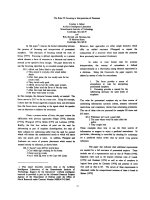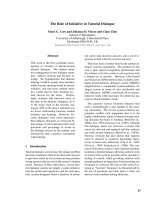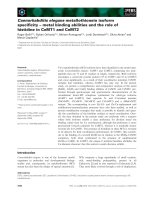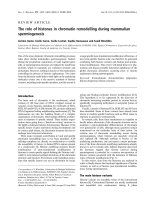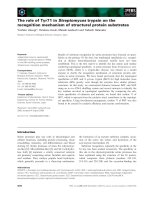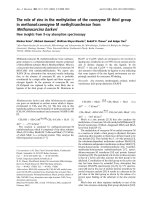THE ROLE OF CERAMIDES IN CIGARETTE SMOKE-INDUCED ALVEOLAR CELL DEATH
Bạn đang xem bản rút gọn của tài liệu. Xem và tải ngay bản đầy đủ của tài liệu tại đây (1.42 MB, 170 trang )
THE ROLE OF CERAMIDES IN CIGARETTE
SMOKE-INDUCED ALVEOLAR CELL DEATH
Krzysztof Kamocki
Submitted to the faculty of the University Graduate School
in partial fulfillment of the requirements
for the degree
Doctor of Philosophy
in the Department of Biochemistry and Molecular Biology
Indiana University
November 2012
Accepted by the Faculty of Indiana University, in partial
fulfillment of the requirements for the degree of Doctor of Philosophy.
_______________________________
Irina Petrache, M.D., Chair
_______________________________
Susan Gunst, Ph.D.
Doctoral Committee
_______________________________
Laurence Quilliam, Ph.D.
August, 22nd, 2012
_______________________________
Simon Atkinson, Ph.D.
ii
Dedication
I dedicate my thesis to my wife, Malgorzata Maria Kamocka.
iii
Acknowledgements
I would like to thank Dr. Irina Petrache for being my mentor during my
graduate program. Dr. Petrache is not only an exceptional scientist, but also an
excellent teacher. Thank you for your advice and guidelines during my scientific
journey. Thank you for support and for teaching me how to think critically, for
teaching me all of the aspects, which are important for a successful scientist.
Thank you for your investment in me, both in funding and time you spent. In your
laboratory I had an opportunity not only to learn how to design, perform
experiments, and analyzed data, but also I was feeling unrestrained due to
freedom for scientific exploration you offered.
I would also like to thank the other members of my research committee:
Dr. Susan Gunst, Dr. Lawrence Quilliam, and Dr. Simon Atkinson. Thank you all
for your time, advice, constructive criticism and support. Your guidance during
my graduate study was extremely helpful.
In addition, I would like to thank all members in Dr. Petrache’s lab, both
present and former. Scientific work demands a lot of cooperation between many
lab members and I had an opportunity to be a part of the great lab team.
iv
Abstract
Krzysztof Kamocki
THE ROLE OF CERAMIDES IN CIGARETTE SMOKE-INDUCED ALVEOLAR
CELL DEATH
The complex pathogenesis of emphysema involves disappearance of
alveolar structures, in part attributed to alveolar cell apoptosis. The mechanism
by which cigarette smoke (CS) induces alveolar cell apoptosis is not known. We
hypothesized that ceramides are induced by CS via specific enzymatic pathways
that can be manipulated to reduce lung cell apoptosis. CS increased ceramides
in the whole lung and in cultured primary structural lung cells. Exposure to CS
activated within minutes the acid sphingomyelinase, and within weeks the de
novo- ceramide synthesis pathways. Pharmacological inhibition of acid
sphingomyelinase significantly attenuated CS-induced apoptosis. To understand
the mechanisms by which ceramides induce apoptosis, we investigated the cell
types affected and the involvement of RTP801, a CS-induced pro-apoptotic and
pro-inflammatory protein. Direct lung augmentation of ceramide caused
apoptosis of both endothelial and epithelial type II cells. Ceramide upregulated
RTP801 and the transgenic loss of RTP801 inhibited only epithelial, but not
endothelial cell apoptosis induced by ceramide. In conclusion, CS induces acid
sphingomyelinase-mediated ceramide upregulation and apoptosis in a cellspecific manner, which in epithelial cells involves induction of stress response
v
proteins that may further amplify lung injury. Molecular targeting of amplification
pathways may provide therapeutic opportunities to halt emphysema progression.
Irina Petrache, M.D., Chair
vi
Table of Contents
List of Schematics ............................................................................................... xii
List of Figures ..................................................................................................... xiii
List of Abbreviations ........................................................................................ xviii
A. INTRODUCTION ............................................................................................... 1
1. COPD ................................................................................................................. 1
1.1. Inflammation in COPD..................................................................................... 2
1.1.2. Ceramides and inflammation ....................................................................... 3
1.2. Protease-antiprotease disequilibrium in emphysema ..................................... 5
1.3. Oxidative stress in emphysema ...................................................................... 6
2. Sphingolipids .................................................................................................... 7
2.1. The role of shingolipids in cell biology ............................................................ 7
2.2. Overview of sphingolipids biochemistry .......................................................... 9
2.2.1. The de novo pathway of ceramide synthesis ............................................... 9
2.2.1.1. Serine palmitoyl transferase...................................................................... 9
2.2.1.2. Ceramide synthases................................................................................ 11
2.2.1.3. Dihydroceramide desaturases ................................................................ 13
vii
2.2.2. Sphingomyelinase pathway of ceramide synthesis ................................... 14
2.2.2.1. Sphingomyelinases ................................................................................. 14
2.2.2.2. Sphingomyelin synthases ....................................................................... 16
2.2.3. Recycling pathway of ceramide synthesis ................................................. 17
3. Apoptosis ........................................................................................................ 18
3.1. Ceramides involvement in apoptosis ............................................................ 21
3.2. Cell specific apoptosis in the lung ................................................................. 22
3.3. Ceramide upregulation in lung endothelial cells ........................................... 23
3.4. RTP801 and lung cell apoptosis ................................................................... 28
B. HYPOTHESIS .................................................................................................. 30
C. MATERIALS AND METHODS ........................................................................ 31
1. Chemicals and reagents................................................................................... 31
2. Mouse strains ................................................................................................... 31
3. Animal experiments .......................................................................................... 32
3.1. Cigarette smoke exposure ............................................................................ 32
3.2. Intra-tracheal instillation of pro-apoptotic molecules ..................................... 32
3.3. Vascular endothelial growth factor receptor (VEGFR) inhibition .................. 33
viii
3.4. Pulmonary function tests (LFTs) ................................................................... 34
3.5. Animal tissue preparation and analysis ........................................................ 35
3.5.1. Broncho-alveolar lavage (BAL) analysis .................................................... 35
3.5.2. Lung tissue harvesting ............................................................................... 35
3.5.3. Histological assessment ............................................................................. 36
3.5.3.1. Hematoxylin and eosin staining .............................................................. 36
3.5.3.2. Detection of Rtp801 by immunohistochemistry ...................................... 37
3.5.3.3. Detection of active caspase-3 by immunohistochemistry ....................... 37
3.5.4. Morphometric analysis ............................................................................... 38
3.5.5. Apoptosis assessment by flow cytometry .................................................. 38
3.6. Enzymatic caspase-3 activity assay.............................................................. 39
3.6.1. Preparation of samples .............................................................................. 39
3.6.1.1. Preparation of cells.................................................................................. 39
3.6.1.2. Preparation of tissue ............................................................................... 40
3.6.2. Caspase-3 activity assay ........................................................................... 40
3.4. Cell culture experiments ................................................................................ 41
4.1. Cell lines used in experiments ...................................................................... 41
ix
4.2. Preparation of cigarette smoke extract ......................................................... 41
4.3. Preparation of treatment media for all culture studies .................................. 42
4.4. Whole lung disintegration .............................................................................. 42
4.5. Isolation of endothelial cells from the lung .................................................... 43
4.5.1. Magnetic labeling of cells ........................................................................... 43
4.5.2. Magnetic separation of cells with MS columns .......................................... 44
4.6. Flow cytometry analysis of apoptosis using Annexin-V/PI detection kit ....... 44
4.6.1. Cells harvest ............................................................................................... 44
4.6.2. Evaluation of apoptosis .............................................................................. 45
4.7. Proliferation assay ......................................................................................... 45
5. Evaluation of lipids ........................................................................................... 45
5.1. Lipid extraction .............................................................................................. 45
5.2. Lipid phosphorus determination by optical density ....................................... 46
5.3. Ceramide quantification................................................................................. 47
6. Enzymatic activity assays................................................................................. 48
6.1. Serine-palmitoyl transferase activity assay ................................................... 48
6.2. Ceramide synthase 2 and 5 assays .............................................................. 48
x
6.3. Sphingomyelinase activity assays................................................................. 49
7. Evaluation of protein concentration .................................................................. 50
8. Western blotting ............................................................................................... 50
9. Additional buffers and media ............................................................................ 51
10. Statistical analysis .......................................................................................... 51
D. RESULTS ........................................................................................................ 52
1. Cigarette smoke (CS) exposure effect on lung ceramides and
apoptosis in vitro and in vivo ........................................................................... 52
1.1. Lung epithelial and endothelial cells increase ceramides and undergo
apoptosis in response to CS ................................................................................ 52
1.1.1. CS exposure inhibits lung cell proliferation in vitro .................................... 52
1.1.2. CS exposure causes lung cell apoptosis in vitro ....................................... 53
1.1.3. CS exposure increases lung cell ceramides content in vitro ..................... 54
1.1.4. CS upregulates enzymes responsible for ceramide synthesis in vitro ...... 54
1.2. CS exposure in vivo increases lung ceramides ............................................ 55
1.2.1. CS exposure increases total lung ceramides and DHC............................. 55
1.2.2. CS exposure activates the SM in vivo in both endothelial and
epithelial type I cells ............................................................................................. 56
xi
1.2.3. CS exposure rapidly activates the SM pathway of Cer synthesis in
the whole lung ...................................................................................................... 57
1.2.4. Chronic CS exposure activates the de novo pathway of ceramide
synthesis in the whole lung .................................................................................. 58
2. Effect of knock-down of enzymes responsible for ceramide
synthesis on lung apoptosis following CS ...................................................... 59
2.1. Effect of inhibition of ASMases on CS-induced lung apoptosis .................... 60
2.2. Effect of inhibition of SPT on lung apoptosis due to CS ............................... 61
3. Role of Rtp801 on ceramide-induced lung cell-specific death ................. 62
3.1. Rtp801 is upregulated in the lung a ceramide-dependent model of
emphysema .......................................................................................................... 62
3.2. Rtp801 is sufficient to trigger lung apoptosis, airspace enlargement,
and to increase lung ceramides ........................................................................... 63
3.3. Direct augmentation of ceramides in the lung increases endogenous
ceramides and causes apoptosis, airspace enlargement, and RTP801
upregulation .......................................................................................................... 63
3.4. Rtp801-null mice are protected from ceramide-induced epithelial cell
apoptosis and emphysema-like disease .............................................................. 65
xii
E. DISCUSSION ................................................................................................... 67
1. Cigarette smoke (CS) exposure increases ceramides both in vitro
and in vivo, which leads lung cell apoptosis .................................................. 67
1.1. Lung epithelial and endothelial cells increases ceramides in
response to CSE, which leads to a programmed cell death ................................ 67
1.1.1. CS exposure inhibits cell proliferation in vitro ............................................ 67
1.1.2. Lung alveolar cells exhibit an increase in apoptosis .................................. 67
1.1.3. CS generates ceramides in vitro ................................................................ 68
1.1.4. CS activates enzymes involved in the synthesis of ceramides ................. 69
1.2. CS upregulates Cer in vivo ........................................................................... 69
1.2.1. Lung Cer and DHC are increase following chronic CS exposure .............. 69
1.2.2. Acute CS exposure activates the SM pathway in the whole lungs ............ 69
1.2.3. Chronic CS exposure activates the de novo pathway of ceramide
synthesis in the whole lung .................................................................................. 70
2. Effect of enzyme inhibition on lung apoptosis following CS .................... 71
2.1. Inhibition of SPT with Myr does not inhibit lung parenchyma apoptosis
due to CS............................................................................................................. 71
xiii
2.2. Inhibition of ASM with Amy inhibited lung parenchyma apoptosis due
to CS ..................................................................................................................... 71
3. Rtp801 is required for ceramide-induced lung cell-specific death in
the murine lungs ................................................................................................ 72
F. FUTURE STUDIES .......................................................................................... 76
REFERENCES ................................................................................................... 121
CURRICULUM VITAE
xiv
List of Schematics
Schematic 1. Sphingolipid metabolism and interconnection of bioactive
sphingolipids ......................................................................................................... 78
xv
List of Figures
Figure 1. Proliferation assay performed on rat lung endothelial cells
following CS exposure.......................................................................................... 79
Figure 2. Evaluation of apoptosis events in lung alveolar cells following
different CS exposure........................................................................................... 80
Figure 3. Ceramide content of lung cells following CS exposure ........................ 81
Figure 4. Effect of CS exposure on the activity of sphingomyelinase
pathway in cultured human lung endothelial cells................................................ 82
Figure 5. Effect of CS exposure on the enzymatic activities in the de novo
ceramide synthesis pathway in rat lung epithelial cells ....................................... 84
Figure 6. Effect of CS exposure on the activity of enzymes in the
sphingomyelinase pathway in rat lung epithelial cells.......................................... 86
Figure 7. CS exposure increases production of ceramides in vivo ...................... 88
Figure 8. Determination of enzymatic activities in sphingomyelinase
ceramide synthesis pathway in both endothelial and epithelial cells type I
isolated from enzymatically disintegrated lungs, following 1 week of CS
exposure ............................................................................................................... 89
xvi
Figure 9. Effect of short term CS exposure on the activity of ceramide
synthesis enzymes in the whole lung tissue of DBA2/J mice .............................. 93
Figure 10. Effect of CS on enzymes of the de novo ceramide synthesis
pathway in the whole lung .................................................................................... 96
Figure 11. Expression of mRNA levels of distinct lung ceramide synthase
isoforms in the whole lung of C57Bl/6 mice following CS exposure for
indicated time ....................................................................................................... 97
Figure 12. CS exposure activates enzymes of the de novo pathway in
the lungs of DBA2/J mice ..................................................................................... 98
Figure 13. Effect of CS exposure on the activity of enzymes in the
sphingomyelinase pathway in the whole lung tissue of DBA2/J mice ............... 100
Figure 14. Effect of the ASMase inhibitor amytriptilline on the lysosomal and
secreted ASMase activities induced by short term CS exposure in
lungs of DBA2/J mice ......................................................................................... 102
Figure 15. Effect of ASM inhibition with amytriptilline on lung apoptosis
following chronic CS exposure in DBA2/J mice ................................................. 104
xvii
Figure 16. Effect of SPT inhibition with myriocin on lung apoptosis following
chronic CS exposure of DBA2/J mice ................................................................ 106
Figure 17. Elevation of lung RTP801 is associated with increases of
airspace size, apoptosis, and ceramide levels................................................... 109
Figure 18. Increases in lung ceramide content are associated with
airspace enlargement, apoptosis, and RTP801 upregulation ............................ 112
Figure 19. Requirement for RTP801 in ceramide-induced apoptosis of
type II epithelial cells and neutrophil infiltration.................................................. 116
Figure 20. Requirement for RTP801 in ceramide-induced changes of lung
alveolar morphology and function ...................................................................... 118
xviii
List of Abbreviations
ATF-2
Activating transcription factor 1
Apaf-1
Apoptotic protease activating factor
BAK
BCL2 antagonist killer 1
BAL
Bronchoalveolar lavage
BAX
Bcl-2 associated X protein
Blc-2
B-cell lymphoma protein 2
CAD
Caspase-activated DNAse
CaN
Calcineurin
CAPK/KSR
Ceramide activated protein kinase/kinase suppressor of Ras
Caspase-3
Cysteinyl aspartic acid-protease-3
Caspase-7
Cysteinyl aspartic acid-protease-7
Caspase-8
Cysteinyl aspartic acid-protease-8
Caspase-9
Cysteinyl aspartic acid-protease-9
CDase
Ceramidase
Cdc-42
Cell division control protein 42 homolog
xix
CD3
Cluster of differentiation 3 molecule
CD4
Cluster of differentiation 4 molecule
CD8
cluster of differentiation 8 molecule
Cer
Ceramide
CerS
Ceramide synthase
COPD
Chronic obstructive pulmonary disease
CS
Cigarette smoke
CSE
Cigarette smoke extract
CXCL10
Chemokine (C-X-C motif) ligand 10
CXCR3
Chemokine (C-X-C motif) receptor 3
C1P
Ceramide-1-phosphate
DAG
Diacylglycerol
DEGS
Dihydroceramide desaturase
DES
Desaturase
DHC
Dihydroceramide
DISC
Death inducing signaling complex
xx
DTT
Dithiothreitol
EGFR
Epidermal growth factor receptor
FADD
Fas-associated death domain
FAN
Factor associated with nSM activation
FasL
Fatty acid synthetase ligand
FasR
Fatty acid synthetase receptor
FBS
Fetal bovine serum
FB1
Fumonisin B1
FITC
Fluorescein isothiocyanate
GCase
Glucosyl ceramidase
GCS
Glucosyl ceramide synthase
GSH
Glutathion
HDL
High density lipoprotein
HLMVEC
Human lung micro-vascular endothelial cell
HtrA2/Omi
High-temperature requirement serine protease Omi
protein A2
xxi
IAP
Inhibitors of apoptosis proteins
ICAM-1
Intercellular Adhesion Molecule 1
IHC
Immunohistochemistry
IL-1β
Interleukin-1 beta
IL-8
Interleukin-8
JNK
c-Jun N-terminal kinase
KDS
3-ketodihydrosphingosine
KO
Knockout
L-ASMase
Lysosomal acid sphingomyelinase
LASS
Longevity assurance genes
LCB1
Long chain base 1
LCB2
Long chain base 2
LCB3
Long chain base 3
LC-MS/MS
Liquid chromatography/tandem mass spectroscopy
LMPA
Low melting point agarose
LPS
Lipopolysaccharide
xxii
LTB4
Leukotriene B4
MAPK
Mitogen activated protein kinase
MAPP
(1S, 2R)-D-erythro-2-(N-Myristoylamino)-1-phenyl-1
propanol
MHC II
Major Histocompatability Complex II
MOMP
Mitochondrial Outer Membrane Permeabilization
MPT
Mitochondrial permeability transition
mRNA
Messenger ribonucleic acid
mTOR
Mammalian target of Rapamycin
MYR
Myriocin
NF-κB
Nuclear factor kappa B
NM
Nuclear membrane
NO
Nitric Oxide
Nrf2
Nuclear factor (erythroid-derived 2)-like 2
nSMase
Neutral sphingomyelinase
xxiii
ORM
Orosomucoid
Ox-stress
Oxidative stress
PARP
Poly(ADP-ribose) polymerase
PAF
Platelet activating factor
PC
Phosphatidyl choline
PE
Phycoerythrin
PEG
Poly-ethylene glycol
PFTs
Pulmonary function tests
PKC
Protein kinase C
PLP
Pyridoxal 5V-phosphate
PM
Plasma membrane
POAS
(PLP)-dependent α-oxoamine synthases
PP2B
Protein phosphatase 2B
Rac1
Ras-related C3 botulinum toxin substrate 1
RIP
Receptor-interacting protein
ROS
Reactive oxygen species
xxiv
RT-PCR
Quantitative reverse transcription polymerase chain
reaction
sASMase
Secreted/soluble acid sphingomyelinase
siRNA
Short interfering ribonucleic acid
SK
Sphingosine kinase
Smac/DIABLO
Second mitochondrial activator of caspases/direct IAP
SM
Sphingomyelin
SMS1
Sphingomyelinase synthase 1
SMS2
Sphingomyelinase synthase 2
SOD
superoxide dismutase
SPPase
Sphingosine phosphate phosphatase
SPT
Serine-palmitoyl transferase
SPTLC
Serine-palmitoyl transferase long chain
S1P
Sphingosine-1-phoshate
TLC
Tram, Lag, CLN8
TNF-α
Tumor necrosis factor alfa
xxv



